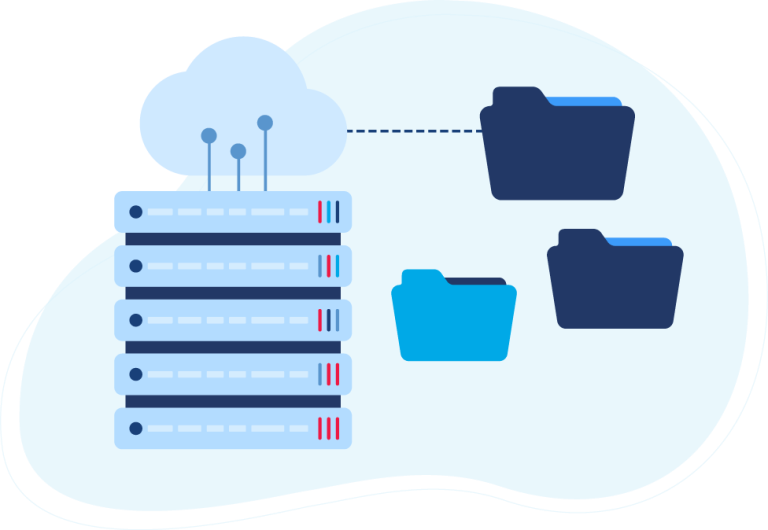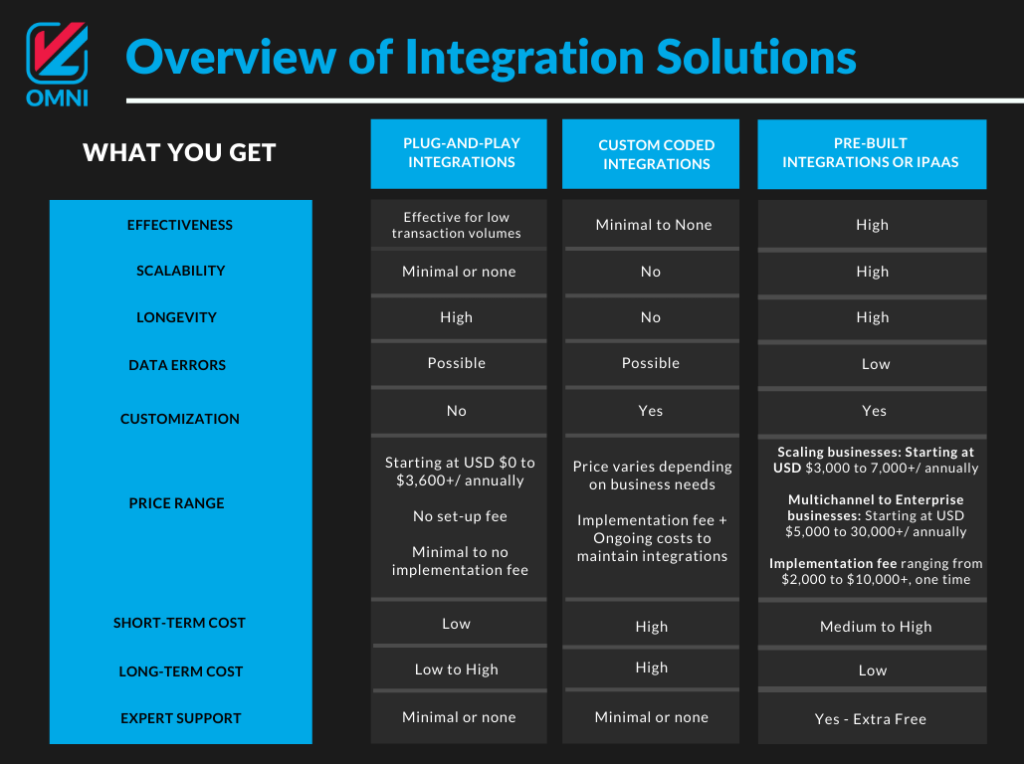Choosing the right data integration solution can be challenging when considering all options available today. In this guide, we will outline a realistic price range for the top data integration solutions in the market and the benefits Merchants can get from each approach.
Whether you know the basics of data integration or this is your first integration project, one of the main questions Merchants often have is “How much is this project going to cost?”. In general, an integration project and its cost depend on various moving parts. This includes the solutions involved and workflows required, the type of integration approach needed – in the cloud or on-premise, and other key factors as each project has its own unique requirements.
But before getting into technical requirements and price ranges, it’s important to understand the benefits of data integration and good flowing data.
What is Data Integration? And The Impact For Your Business
In today’s connected world, cloud software is leading the way. With a wide variety of applications existing on the cloud that are easy to deploy, the biggest challenge is how to centralize all data and applications to gain broader visibility. Merchants need to understand data in aggregate and not in isolation. Data integration is the process of pushing data from disparate sources into a central destination for analysis and visibility across the business.
The Importance of Data Integration For Scaling Brands
Although this may sound like a no-brainer, the reality is that, without a good data integration strategy in place, relevant data can quickly become siloed and fragmented across teams. This leads to a lack of visibility and more manual processes and data errors across your business.
As the volume of data and complexity grows, your business will likely need efficient data integration across your inventory and fulfillment network to unify operations and ensure you stay stocked and profitable. Simply put, data integration is how your brand can become a scalable commerce machine.

Top Data Integration Solutions and Their Price Ranges
Choosing the right data integration solution can be challenging when considering all options available today. However, it’s important to make an educated decision and choose a solution that fits your business use case, budget, goals, and needs long-term.
Before committing to a solution, consider how your data sources will be supported at scale. It’s essential to implement an integration solution that can grow with your business.
See the chart below for a breakdown of the benefits and price ranges for the most common data integration solutions.
** Merchants can expect to compare and look for the above benefits and price ranges when researching integration solutions. This detailed list of benefits and price ranges encompasses public information from top data integration vendors in the market.
Cost-Benefit Analysis of Data Integration Solutions
At a high level, the cost of data integration will vary based on the type of business, the number of workflows required, the type of integration solution, and the level of functionality needed. As shown in the chart, integration costs include labour costs, implementing and consulting fees, and any other expenses relating to the integration process.
One thing to note: While price can determine the budget for the integration project, it is always recommended to compare various factors against the benefits that come with the integration solution. See our complete guide with examples of what data integration should cost.
As mentioned earlier, all integration solutions will provide the functionality to automate data flows across your business. However, Merchants must evaluate the effectiveness, scalability, and long-term integration costs of each solution before committing to one.
To help you choose the best option for your business, we’ll break down each integration solution and key benefits below.
Predominantly, there are 3 top data integration solutions:
Plug-and-Play (Point-to-Point) Integration
Plug-and-play integrations work like convenient and cost-effective apps or add-ons. In fact, they can either be free or have a low cost. Unlike other robust integrations, point-to-point integrations typically only manage common workflows at a basic level.
In general, they are one-size-fits-all solutions as they cannot change to fit exact needs, have limited functionality, and can only handle limited value. That’s why plug-and-play integrations are not flexible to accommodate larger processes typically done by growing businesses.

Custom Coded Integrations
Custom coded solutions are ideal for larger enterprise-level businesses with an IT team that can maintain the custom programming integrations and extensive documentation. While technology investments like integration need to be resilient to change, DIY integrations are structurally rigid. Every change or new integration would have to be manually hardcoded for each project – every time. Making the integration solution heavily dependent on technical resources to scale.
Pre-Built Integrations or iPaaS
Pre-built or bespoke integration solutions can carry out a variety of integration patterns – not just point to point. They have the unique ability to modify and clone workflows in real-time, meaning less time and money to get new connections up and running.
In contrast to the DIY approach, a pre-built integration, or iPaaS solution, promotes agility, flexibility, and efficiency. These integrations make adding, modifying, or removing new channels, trading partners, or applications easy as they are not constrained to a linear function.
iPaaS solutions serve as a central point for different applications for businesses with complexity and a growing number of transactions. This is how the biggest names in eCommerce can keep up with their growth while consistently creating a flawless customer experience.
VL OMNI: We are an integration partner that guides your growth
More than providing you with a dashboard for your integrations, iPaaS solutions like VL OMNI empower growing brands to obtain strategic, outside-in visibility into data flows happening across their applications, partners, marketplaces, orders, and more. All thanks to our agile and scalable iPaaS built on cutting-edge technology.
The VL OMNI’s integration platform has the ability to move data from a single application to many. We’re able to run workflows in parallel without interfering with other processes. Plus, all VL OMNI Connectors can move data both into and out of any particular application. As an official Integration Partner of Shopify Plus since the inception of the program, we’re extremely experienced with integrating the eCommerce platform to a variety of applications.
We don’t publish our pricing because we don’t force Merchants into a boxed solution. Our sales process involves understanding your business and what’s important to you, and no other businesses alike.
Are Data Integration Projects Expensive?
The initial cost of a data integration solution should not be the only force driving your enterprise decisions. While cost of implementation is a critical factor to consider in terms of budget, you must consider maintenance cycle costs. Brands’ data needs are rarely static. To accommodate ever-changing business needs, demands and complexity, Merchants need to consider a solution that is effective short-term and long-term. Beyond the initial cost of an integration solution, support costs, flexibility, and scalability must be thought through.
Where You Should Begin with Data Integration
Getting started with data integration can feel overwhelming, but it is fundamental to consider the following steps:
- Define a list of goals and must-haves for each application, including functionality, eCommerce needs, APIs, and more.
- Narrow down the integration solutions that meet the above needs
- Compare and contrast functionality, user experience, short-term and long-term costs, and benefits from all the solutions – and document findings.
- Reach out to qualified integration vendors. Communicate your needs and goals as well as dig into technical requirements and think at scale.
- Find the right integration partner to guide you through the journey of unifying your sales channels and growing at scale. Don’t forget to keep a close eye on how long the data integration solution takes to implement.
Integration Starts Here!
Finding software can be overwhelming. VL OMNI has helped hundreds of global brands choose the right data integration solution that fits their needs and goals. More than an integration platform, we are a partner that guides your integration journey and helps your business scale faster while selling more.
 D365 Business Central
D365 Business Central Netsuite
Netsuite



